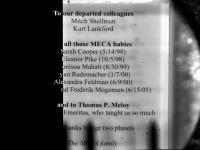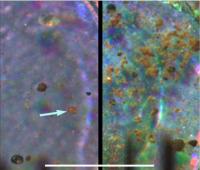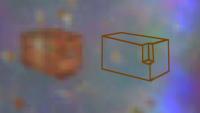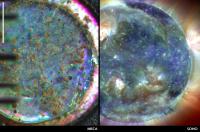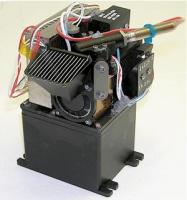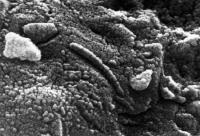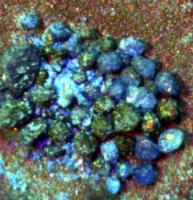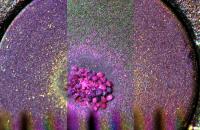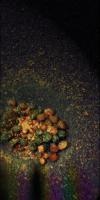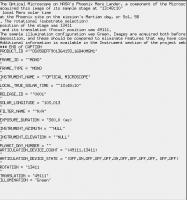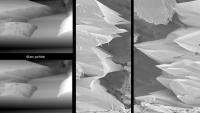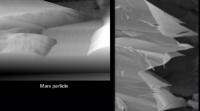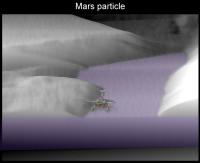Printable Version of Topic
Click here to view this topic in its original format
Unmanned Spaceflight.com _ Phoenix _ MECA (microscope) Images
Posted by: Astro0 May 30 2008, 08:19 AM
Doug I know this isn't exactly a "sub-element activity", but it's certainly a small image.
Can someone tell us anything about this MECA plaque. They don't seem to have captured the entire thing in their shots and it would be nice to fill in some of the blanks. I've inserted some assumptions in the attached merged image.
Just love these sort of personal touches which have stories linked to them. My name is on the mini-DVD...who else on UMSF signed up?
Astro0
Posted by: jamescanvin May 30 2008, 08:27 AM
--Split MECA posts to a dedicated thread
I'm on the DVD ![]()
I read about the MECA plaque a while back, now where was it?...
Ah yes the BBC Phoenix blog (near the bottom):
http://news.bbc.co.uk/1/hi/sci/tech/7408033.stm
Their names, together with those of our colleagues who did not live to see Phoenix launch, form part of an eyetest chart

Posted by: Skyrunner May 30 2008, 08:54 AM
Ehhh...about everyone I suppose...Certainly my name is on it. Next time we should get our name on it automatically since we're UMSF
Posted by: jamescanvin May 30 2008, 09:05 AM
Just join the Planetary Society to get that treatment. ![]()
Posted by: djellison May 30 2008, 09:08 AM
I assume everyone here is a member already. If they're not, they damn well should be. As a Brit who can't pay US taxes, it's the only thing I can do to contribute in a meaningful way to this sort of stuff.
Doug
Posted by: ahecht May 30 2008, 01:45 PM
It's amazing to think that some of the MECA babies are now 10 years old (although technically they were born during the creation of the Mars Environmental Compatibility Assessment for the canceled Mars Surveyor 2001, not the Microscopy, Electrochemistry, and Conductivity Analyzer for Phoenix -- same basic instrument, different name)
Posted by: ilbasso May 30 2008, 02:08 PM
Doug
Doug, if you really want to pay US taxes, I'll be glad to work out a plan by which you can help me "contribute."
Jonathan
Posted by: imipak May 30 2008, 10:35 PM
I'm on the DVD, and I'm both happy and embarrassed to say that it was a pointy remark from Mr Ellison on UMSF that prompted me to join in the first place, and to punt funds at various other related projects.
Posted by: CosmicRocker May 31 2008, 04:32 AM
My name is on the disk, as are the names of everyone in my immediate family. It's kind of like riding in economy class. It would be so much nicer to have a place in first class, the plaque on the lander. ![]()
As for the microscopic imager, does anyone know what it was that it recently imaged?
Posted by: djellison May 31 2008, 08:32 AM
It'll have imaged the sample collecting areas on the disk as a baseline before covering them in 'stuff' I would have thought. I was suprised we didn't see a OM guy at the press conf yesterday.
Doug
Posted by: ustrax May 31 2008, 02:02 PM
Even my dogs are there... ![]()
My dearest http://docaminhar.aminus3.com/image/2007-04-05.html and http://i16.photobucket.com/albums/b14/ustrax3/bingo.jpg who, having passed away without witnessing the arrival of Phoenix but that makes me dream that there he is...quite happy and ready to dig all the way to the ice... ![]()
Posted by: ahecht Jun 5 2008, 09:11 PM
The first optical microsope images of Mars dust have been posted at http://www.jpl.nasa.gov/news/phoenix/main.php
- http://www.jpl.nasa.gov/images/phoenix/collection_16/OM1_05JUN08_mhh_800-600.jpg
- http://www.jpl.nasa.gov/images/phoenix/collection_16/OM2_05JUN08_mhh_800-600.jpg
- http://www.jpl.nasa.gov/images/phoenix/collection_16/OM3_05JUN08_mhh_800-600.jpg
- http://www.jpl.nasa.gov/images/phoenix/collection_16/OM4_05JUN08_mhh_800-600.jpg
Posted by: Stu Jun 5 2008, 09:46 PM
I'm looking forward to the informed discussion here on UMSF about just what these images show, because, hands up, I haven't a clue. They look fascinating, but as for what's in them... ![]()
![]()
![]()
Posted by: fredk Jun 5 2008, 09:58 PM
At today's press conference they more or less said that they are probably grains kicked up by the exhaust during landing, but they can't be sure they're of Martian (rather than Phoenix) origin until they grab what they know is a Martian sample with the arm and look at it. There was some discussion of the white grain (definitely not ice - it would have sublimed before the image was taken).
Posted by: Gray Jun 6 2008, 08:09 PM
Wow. These are very interesting images of possible martian sedimentary particles. It's really hard to say too much about "grains mounts" such as this. You can look at the grain shape, it's opacity, and it's color - but it's hard to make any comprehensive analyses based on only that information.
A grain that is interesting to me is the pinkish, rectangularly shaped one that is "southeast" of the middle grain noted in the microscopic image. Halite frequently shows up as rectangular grains and can be stained pinkish by hematite - but then, other minerals can be pinkish and rectangular too. (shrug)
Posted by: CHOAM Jun 6 2008, 10:27 PM
My first guess was salt or silica, but I'm no geologist, and Emily Lakdawalla has posted a more informed opinion on this:
http://www.planetary.org/blog/article/00001497/
Re. requiring a volcanic origin for silica: I'm guessing a grain of that size could be lofted and carried to a polar position, given a few billion years...
- CH
Posted by: dvandorn Jun 7 2008, 04:58 AM
Isn't this the kind of thing that the atomic force microscope could help settle? Silica flakes and salt crystals have rather unique and recognizable structures at atomic force scales, don't they?
-the other Doug
Posted by: Airbag Jun 12 2008, 05:09 PM
First sample sprinkled onto the microscope inlet:
http://www.met.tamu.edu/mars/i/SS017EFF897718135_12370R6M1.jpg
Hope not too much went into the far right wet chem sampler MECA inlet...it does have its own open/close valve, but what happens to material already in that little hopper? Or is it open at the bottom until the MECA valve is in the "accept sample" position, so that any unwanted material just falls though?
Airbag
Posted by: jamescanvin Jun 12 2008, 07:37 PM
Sounds like the team is happy with the sprinkle into the Microscope. ![]()
http://phoenix.lpl.arizona.edu/06_12_pr.php
Posted by: ahecht Jun 13 2008, 08:20 PM
The images of the first sample have come down. Click each image for a link to the full size:
http://phoenix.lpl.arizona.edu/images/gallery/lg_4869.jpg
http://phoenix.lpl.arizona.edu/images/gallery/lg_4867.jpg
http://phoenix.lpl.arizona.edu/images/gallery/lg_4859.jpg
http://phoenix.lpl.arizona.edu/images/gallery/lg_4870.jpg
Posted by: Shaka Jun 13 2008, 09:43 PM
Interesting amber crystalline-looking particle (blue arrow).
I hope we see lots more.
Speculation time!
Posted by: centsworth_II Jun 13 2008, 10:33 PM
Cubic? With (if I may be so bold) a corner taken out.
Posted by: Shaka Jun 13 2008, 11:10 PM
Oddly, I see a cylindrical 'hatbox', complete with lid, but then I'm a planktonologist with search "expectation" for centric diatoms.
Posted by: fredk Jun 13 2008, 11:48 PM
We had a comment on that arrowed grain earlier in this thread - the left half of that image was from the first batch taken about a week ago, before the soil was sprinkled...
Posted by: imipak Jun 14 2008, 08:53 AM
Am I right in my impression that the consensus is that any ice particles would have sublimed away by now? If so, can these whiteish particles or grains be anything else but salts? 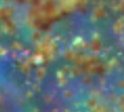

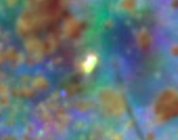
(Edit, having seen fredk's animation of particles vanishing from the trenches in the other thread: I meant that isolated icy particles on this microscopic scale would have sublimed away ![]() )
)
Posted by: Decepticon Jun 14 2008, 12:12 PM
The images seem a bit out of focus?
Posted by: SickNick Jun 14 2008, 03:32 PM
Decepticon,
They're trying to focus grains that are fatter than the depth of focus of the instrument. In the geological world, we take a rock, or a pile of grains, glue it all together with Araldite/Epoxy, cut a slice, and grind it down to less than 30 microns thick. We still have focus issues.
here, they're taking raw grains up to 1/10 mm size (100 microns) and trying to focus them.
Focus and resolution are not independent entities. if you want to "see" grains 1 micron in size - as we do, then anything bigger than 1 micron will be out of focus.
Posted by: Decepticon Jun 14 2008, 03:49 PM
Thanks for that explanation!
Posted by: Airbag Jun 14 2008, 04:26 PM
Yes, but the instrument is designed to take multiple (8) images at different focus distances, each with a depth of field of 50um. These multiple "vertical slice" images are then used on the ground to reconstruct an image where all parts (up to 200um deep) are in sharp focus, just as was done for MER's MI images, but on a much smaller scale of course. So I expect that eventually we will see images where all grains are in sharp(er) focus - assuming that was not already done!
Unfortunately, the Optical Microscope (OM) images do not show up on the otherwise very useful http://www.met.tamu.edu/mars/directory.html web pages so there is no obvious way to tell how many "different depth" OM images have been taken and/or downloaded so far.
Does anybody know if the raw OM images are available online anywhere?
Airbag
Posted by: Decepticon Jun 14 2008, 05:27 PM
Even before I could ask It was answered!
I can't wait to see this!
Posted by: ahecht Jun 14 2008, 06:01 PM
Give how easy it is to misidentify mircrosope images to those untrained in the art (as shown even in this thread), i'm sure they wouldn't release raw images until they had a chance to caption them. You wouldn't want a stray flourescent fiber from a laboratory Kimwipe sparking "Life Found on Mars" headlines.
Posted by: ugordan Jun 14 2008, 06:03 PM
By that token no raw images would ever be released because cosmic ray hits would inevitably be (and have been) interpreted as artificial objects in the distance, UFOs, etc.
Posted by: climber Jun 14 2008, 07:11 PM
Which was not the case of Holland against France yesterday
Posted by: Astro0 Jun 15 2008, 03:00 AM
I just love it when images like this come together.
From the very small (on Mars) to the very big (our Sun).
Phoenix and SOHO images side by side make an interesting comparison.
Enjoy
Astro0
Posted by: nprev Jun 15 2008, 03:31 AM
![]() ... damn! That's actually more than a bit profound, but won't get into it here.
... damn! That's actually more than a bit profound, but won't get into it here.
EDIT: Ah, what the hell: perception is an integral part of existence. Maybe we see things of wildly different origins in similar ways just to try to make sense of it all. We are limited in so many ways.
Posted by: Gray Jun 16 2008, 03:47 PM
I hope we see lots more.
Speculation time!
I found that grain to be of interest too.
I also thought that it looked more cubic than round. I even speculated that it might be halite. But of course, halite isn't the only mineral to break into cubiform shapes.
One interesting quality of the grains is that many of the larger grains are rounded - which suggests a fairly high degree of abrasion. It's not surprising, given the degree of aeolian activity on the planet...
Posted by: Airbag Jun 17 2008, 02:09 AM
Interesting image and explanatory text of various substrates and soil samples for use with the Atomic Force Microscope:
http://www.nasa.gov/mission_pages/phoenix/images/press/sol_17_nanobucket_mosaic_rotated.html
Airbag
Posted by: Juramike Jun 17 2008, 11:31 AM
http://www.nasa.gov/mission_pages/phoenix/images/press/sol_17_nanobucket_mosaic_rotated.html
From the caption: "The strip third from the left, with a peg spacing of 5 micrometers, has been most successful in collecting the particles."
To put into perspective, grain sizes less than 4 um are considered "fine-grained". On Earth, once compacted and cemented together, these grains could form fine-grained sedimentary rocks like mudstones and fine-grained shales.
-Mike
Posted by: MahFL Jun 17 2008, 02:36 PM
You know if no one had said anything I too would have thought those we the same type of image of the microscope view.
We are made of the same stuff stars are made of.
Posted by: elakdawalla Jun 18 2008, 12:10 AM
By the way, I asked about the status of OM images on the raw images website, and was told they're reworking how the captions are generated for the images, and that once they're done with that work the images should start showing up again, hopefully within a few days from now. I don't know if this means that older images will be posted or not.
--Emily
Posted by: gallen_53 Jun 18 2008, 01:18 AM
Could it be iron pyrite?
Posted by: Shaka Jun 18 2008, 04:21 AM
![]() Translucent?
Translucent?
Posted by: Aussie Jun 18 2008, 06:37 AM
Looks tetragonal
Posted by: Stu Jun 18 2008, 07:06 PM
http://photojournal.jpl.nasa.gov/catalog/PIA10799 little animation just cries out to be shown on a big screen... Hold onto your chair arms though... !
![]()
Posted by: brianc Jun 19 2008, 06:40 AM
This may be of interest - Dr Tom Pike - MECA - Diary on BBC News website
http://news.bbc.co.uk/1/hi/sci/tech/7408033.stm
Posted by: MahFL Jun 23 2008, 07:35 PM
Sample delivery to MECA ?
Posted by: ElkGroveDan Jun 23 2008, 07:44 PM
Looks like my kids were playing around there.
Posted by: jmknapp Jun 23 2008, 09:01 PM
It's interesting that of all the scientific data amassed by the spacecraft, only photographic data is released immediately in (somewhat) raw form. In the spirit of getting greedy, why not, for example, raw temperature/pressure readings throughout the day from the weather instruments, or dust readings from the laser?
Posted by: helvick Jun 23 2008, 09:51 PM
The photographic data that we get is "obfuscated" slightly by the auto-levelling process used to make the images look acceptable for general purpose web browsing, that also eliminates much of the risk of anyone confusing the quickly released images for calibrated data.
The more basic non image data (like temperature measurements) present a problem because there is no acceptable way to carry out a similar sort of modification of the data that preserves an effective presentation of the form of the data without being too specific (so as to prevent confusion between uncalibrated and calibrated data).
Posted by: silylene Jun 24 2008, 10:01 PM
Do any of you know what, if any, are the possible sources of tiny fibers which could have fallen onto the collection slide from the lander? For example, thermal blankets, insulation, or a woven wrapping around a cable ?
thanks!
Posted by: djellison Jun 25 2008, 09:44 AM
Got a sample image?
Posted by: silylene Jun 25 2008, 12:07 PM
There is a small fiber stuck which to me appears to be stuck by one end on the slide, the other end of which which appears to move in the wind by time lapse, perhaps also as focus was changed. (Perhaps the focal change makes it appear to move? I don't think this is the case.)
See the post by rlb2 who found this first in the middle of this page, for stills, and also read the discussion for the exact location: http://www.space.com/common/community/forums/?plckForumPage=ForumDiscussion&plckDiscussionId=Cat:c7921f8b-94ec-454a-9715-3770aac6e2caForum:bf7b9387-46b4-47ed-ad5b-34a5350b82ecDiscussion:9a92d6c4-86a5-4b35-8183-6c97a30c6f8c&plckCurrentPage=40&sid=sitelife.space.com
And here is a Flash animation of the apparent movement by a_lost_packet: http://www.zshare.net/flash/140388723809779c/
rlb2 has estimated the fiber's length to be 0.1 mm. In some posts, this apparently moving fiber has been termed a 'worm'. (and no, I don't think there is any chance that it is, though it is amusing!) I am just interested in what are the sources of fibers which could have fallen off the lander and onto the slide.
Posted by: djellison Jun 25 2008, 02:17 PM
Given that this is from a clean slide that hadn't been exposed to the landing dustfall - anything seen is simply artifacts of a non-perfect collection slide. The illumination is entirely from within the OM ( http://www.mps.mpg.de/images/projekte/phoenix/meca-om/meca-om01_xxl.jpg ) and the LED's are in a ring around the OM optics, causing the change in shadows as the different LED's are turned on to image the slide. Notice how the 'worm' moves in exactly the same way as the shadow around all the other imperfections on the substrates?
Disappointing, but not all together surprising that people would try and make something out of it.
Posted by: silylene Jun 25 2008, 03:29 PM
Thanks for the explanation and picture.
Posted by: ahecht Jun 26 2008, 09:58 PM
There are many things in a clean room which could leave tiny 0.1mm fibers in the microscope: the bunny suits, hair nets, booties, kimwipes, paper, etc. Any of those that contained optical brighteners (such as white paper or laundered fabric) would also fluoresce in UV.
Posted by: Ipparchus Jul 7 2008, 07:49 AM
Do you know when are they going to use the Atomic Force Microscope? why didn`t they use it so far?
Posted by: Del Palmer Jul 7 2008, 12:00 PM
Probably real soon now. From Mark Lemmon's raw images page:
Sol 042: Clean and scrape Wonderland, AFM checkout part 1
Posted by: Ipparchus Jul 9 2008, 10:46 AM
Do you know if the Atomic Force Microscope could detect and "photograph" any (possibly existing) micro-organisms in the soil samples? what size(nm) should the microbes have to be detected?
Posted by: 1101001 Jul 9 2008, 04:04 PM
http://phoenix.lpl.arizona.edu/science_meca.php
[...]
The atomic force microscope will provide sample images down to 10 nanometers - the smallest scale ever examined on Mars. Using its sensors, the AFM creates a very small-scale "topographic" map showing the detailed structure of soil and ice grains.
Posted by: elakdawalla Jul 9 2008, 04:07 PM
See http://www.planetary.org/blog/article/00001542/ -- they hope to finish characterization of the Atomic Force Microscope tosol, so we should shortly begin to see it being used on samples already tagged in the OM.
--Emily
Posted by: Phil Stooke Jul 9 2008, 04:14 PM
Can we identify the Vestry location in an image?
Phil
Posted by: TheChemist Jul 12 2008, 07:56 PM
The first AFM image of a test material was obtained.
So at least we know the AFM works as planned.
http://www.jpl.nasa.gov/news/phoenix/images.php?fileID=14644
Posted by: remcook Jul 22 2008, 01:09 PM
For those who haven't seen it yet, there's a new installment in Tom Pike's BBC blog:
http://news.bbc.co.uk/1/hi/sci/tech/7408033.stm
Interesting bit about the AFM:
"The particles, though, are much more difficult to image. They tend to be pushed about by the sharp tip of the AFM, frustrating our attempts. On Earth, we'd be able to turn a few knobs to minimise the forces between the tip and the particle.
For Phoenix, each "tweak" of the computer code takes hours to prepare and the results from Mars aren't known until the next sol. We also have to book ahead to be able to run our microscopes on Phoenix.
What takes just a few minutes to run on the testbed in our laboratory in Tucson takes several sols to complete on Mars. A good deal of patience is a requirement for any member of the science team. "
Posted by: jmknapp Jul 22 2008, 03:24 PM
Roadblocks on all fronts, it seems.
In the BBC blog, I wonder what the point is of making soil/ice mixtures in one's kitchen--not exactly Mars conditions.
Posted by: MahFL Jul 22 2008, 04:01 PM
I wonder if they anticipted this problem. In laymans terms, its not working.
Posted by: Juramike Jul 22 2008, 04:01 PM
I'd guess that they are taking the soil/ice mixtures and then putting them under partial vacuum (or what passes for atmospheric pressure on Mars) and watching stuff sublime.
[BTW, we do this all the time with water-soluble compounds. Dissolve in water, freeze, then put under a high vacuum to sublime out the water. The dissolved stuff slowly precipitates out in the frozen matrix and becomes hyperfluffy. The lyophilization process makes it real easy to manipulate miniscule amounts of material (sub-milligram quanities) with a laboratory spatula.]
-Mike
Posted by: Aussie Jul 23 2008, 12:08 AM
They did. The substrate etching/holes were specifically designed to bound trapped particle size and minimise the movement of those particles. Given time they will probably be able to adjust the focus to reflect the sample, but the tip is delicate and vulnerable to the effects of rough particles. Overall the inclusion of the AFM seems somewhat of a gamble and possibly this is why there is an AFM shaped hole in the Mission Success Criteria.
Posted by: nprev Jul 23 2008, 02:04 AM
Have to ask why it's even considered part of the mission success criteria, then. Nobody's ever flown an AFM before, AFAIK; if so, this is a pathfinder effort. Deploying the thing and getting a read on the control target is a success, as far as I'm concerned. Learning about the effects of environmental variables is one reason it's there in the first place.
Posted by: jamescanvin Jul 23 2008, 07:17 AM
According to Mark in the http://www.unmannedspaceflight.com/index.php?s=&showtopic=5335&view=findpost&p=121188 use of the AFM is not a mission success criteria. The OM alone is enough to satisfy "It shall also analyze 3 additional samples in its microscopy station."
Posted by: Aussie Jul 23 2008, 07:38 AM
Poor use of language. By 'an AFM shaped hole in the Mission Success Criteria' I meant that the AFM was not included in the criteria. I agree with Mark.
Posted by: CosmicRocker Jul 24 2008, 04:56 AM
http://news.bbc.co.uk/1/hi/sci/tech/7408033.stm
Interesting bit about the AFM:
"The particles, though, are much more difficult to image. They tend to be pushed about by the sharp tip of the AFM, frustrating our attempts. On Earth, we'd be able to turn a few knobs to minimise the forces between the tip and the particle.
For Phoenix, each "tweak" of the computer code takes hours to prepare and the results from Mars aren't known until the next sol. We also have to book ahead to be able to run our microscopes on Phoenix.
What takes just a few minutes to run on the testbed in our laboratory in Tucson takes several sols to complete on Mars. A good deal of patience is a requirement for any member of the science team. "
I couldn't help but wonder though, about the "computer code tweaking/uplinking/downlinking" strategy. Might it not be easier to simply move the tip to another potentially trapped particle, and try to probe it with the default parameters? I suspect my ignorance of interplanetary AFM operations prevents me from seeing the errors in my suggestion, but I couldn't help but speak my mind.
Posted by: teck Jul 24 2008, 07:50 PM
Anyone wants to identify these tiny grains from the OM?
This looks like a nice catch.
Posted by: jmknapp Jul 24 2008, 08:13 PM
J-j-jumping Juniper! A golden egg! T-twenty-four karat dilithium crystals! We're rich!
Posted by: djellison Jul 24 2008, 10:20 PM
The colours are really hard to pull out - looks cool though. This is a mosaic of three obs that cover the whole substrate.
Posted by: Stu Jul 24 2008, 10:31 PM
I got this... probably 1000% wrong but I just fell in love with the colours!
They look like tiny beads of amber... ( I know they're NOT, before anyone says anything!
Posted by: Shaka Jul 24 2008, 11:27 PM
Is there no official description of this OM? Was this a sample that should have included ice? Maybe ice granules become more spherical as they sublimate.
![]() Where are these OMs being made public? How many have been made? I wanna SEE this stuff!
Where are these OMs being made public? How many have been made? I wanna SEE this stuff!
Posted by: nprev Jul 25 2008, 12:15 AM
Hmm...wind-eroded (rolled around), or is there an erosional effect on the material from the seasonal frost? If this was from Earth I'd say they were silica, but not here. Olivene?
Posted by: Aussie Jul 25 2008, 02:27 AM
Right on! What was the LED combination used. What was the substrate. We want to know what the real colour was. Enough already guys, stop teasing!
Posted by: 1101001 Jul 25 2008, 02:44 AM
http://phoenix.lpl.arizona.edu/images.php?gID=0&cID=173
For instance the green-illumination image of the wee balls is, 13:48:10 local Mars time, substrate selection 13411, etc.:
http://phoenix.lpl.arizona.edu/images.php?gID=15537&cID=173
Posted by: Shaka Jul 25 2008, 05:17 AM
Thanks, 0110...011...1... Do you mind if I call you '0'?
As the current "newby-in-the-know", are you the one to quiz about OM images?
Has anyone explained how all these...emeralds...er...rubies...amethysts...popsicles?
managed to get all clustered in the lower left corner of the field?
(I assume my biologist's explanation of gregarious behavior in Volvox colonies is inadmissible.) ![]()
TIA,
Shaka
Posted by: CosmicRocker Jul 25 2008, 06:41 AM
They are very pretty grains. The illumination was RGB for some of the false color images we've seen here. The substrate was the "strong magnet", per the http://phoenix.lpl.arizona.edu/micro_table.pdf
Posted by: djellison Jul 25 2008, 07:10 AM
Raw JPG's and Real Colour are essentially mutually exclusive.
Posted by: Stu Jul 25 2008, 07:12 AM
Thanks for the link CR, very useful and interesting. I'm looking forward to seeing what the real imaging experts here do with the microscope images coming down. I didn't think I'd find them so interesting, if I'm honest... I'm definitely a "rocks" fan rather than a "grains" fan, but there's something fascinating about seeing Mars in such close-up...
While I'm here, can I just invite everyone over to my new http://phoenixpics.wordpress.com? I thought it made sense to tidy up all my clutter and put it in one place. It's going to be a gallery of unashamedly pretty pictures, with no claims of accuracy or scientific worth; just my own cosy little den where I can hang my favourite pics and share them with anyone who wants a look, too... Hope some of you will drop by - and if you'd like a link to your own pictures site putting on it, just drop me a line, ok?
Posted by: teck Jul 25 2008, 10:59 AM
Here is the caption for one of the jpg:
This should help
Posted by: jmknapp Jul 25 2008, 11:24 AM
So, high in iron--meteoric?
Posted by: Aussie Jul 25 2008, 12:38 PM
Thanks for the pointers. All of a sudden it is all so clear. I will read the website properly next time.
Posted by: elakdawalla Jul 25 2008, 05:17 PM
That is an extremely useful link, CR. Where did you find it -- where is it linked from? I'm wondering if this is a file that they update or if it's a one-time report. Since it only goes out to sol 30 it seems it may be a one-time report...
--Emily
Posted by: 1101001 Jul 25 2008, 07:25 PM
Link to table is here: http://phoenix.lpl.arizona.edu/science_micro.php
Posted by: CosmicRocker Jul 26 2008, 04:27 AM
You probably know this, but I neglected to mention that one needs to determine the sample "rotation" to figure out which substrate was imaged. Since this is not currently metadata that is being captured by MMB in the .csv file it writes for the Pheonix images, you'll need to open the jpeg image in a text editor to read it, as teck demonstrates above.
Posted by: Aussie Jul 26 2008, 07:58 AM
CR.
The rotation numbers, lighting etc are recorded in the image description that can be read by clicking the thumbnail and then hovering the cursor over the larger image. But the table is the key to correlating this to the OM designation and hence the substrate. Given this I would have expected the OM designation and the rotation position to be fixed. They are not and some OM images from SOL 58 nominate rotation positions that do not appear in the table against an OM number. So I retract my previous statement. It isn't clear after all.
Posted by: teck Jul 26 2008, 12:14 PM
The rotation numbers, lighting etc are recorded in the image description that can be read by clicking the thumbnail and then hovering the cursor over the larger image. But the table is the key to correlating this to the OM designation and hence the substrate. Given this I would have expected the OM designation and the rotation position to be fixed. They are not and some OM images from SOL 58 nominate rotation positions that do not appear in the table against an OM number. So I retract my previous statement. It isn't clear after all.
The table still applys. The rotation number is given as nominal position. If you take set number 8, all rotation numbers fall in the range given. When the position is not in the table, it is generaly an offset from a nominal position. You can see this in the image where the edge of the frame is seen.
The image shown previously is possibly misleading concerning the origin of the grains. I could not find the calibration image before the sample was taken. There is a dark frame taken at this position but it is taken after the sample image
Posted by: CosmicRocker Jul 27 2008, 04:41 AM
Thanks for reminding me about the mouse-over info, Aussie. I had forgotten the info was available there, since I typically mass-download the images using MMB, and I only occasionally use that raw images page.
teck: What do you mean by, "The image shown previously is possibly misleading concerning the origin of the grains." ...?
Posted by: CosmicRocker Jul 27 2008, 05:00 AM
Sorry, the devil made me do it.
Posted by: teck Jul 27 2008, 09:45 AM
Because this is a strong magnet, the grains could have been there a long time ago. As I mentioned, unless there is an image showing the same target before a sample was taken, we cannot say where the grains came from. I did not find it.
Posted by: dvandorn Jul 27 2008, 04:11 PM
Oooh... I've been trying the same thing, CR, and I've been using both good-quality wands and multi-person spell casting, so far with no luck. Tell me, have you decided whether or not to use live sacrifices? I've not yet committed to that level of effort, alas.
-the other Doug
Posted by: ahecht Aug 1 2008, 05:18 PM
From what I can tell, the photo of the clump is the "before" photo (that is, before a sample was deposited there). In the past they have done an empty image before a "full" image, and I couldn't find any earlier images of that particlular section of the sample wheel. The particles clumped around the magnet probably fell off of the other substrates as the wheel was rotated.
Posted by: 1101001 Aug 1 2008, 08:32 PM
Covault's article:
http://www.aviationweek.com/aw/generic/story_channel.jsp?channel=space&id=news/WH08018.xml&headline=White%20House%20Briefed%20On%20Potential%20For%20Mars%20Life
(I didn't notice this MECA topic was more about imaging. This news is about MECA WCL, wet chemistry laboratory. I added http://www.unmannedspaceflight.com/index.php?showtopic=5359&pid=122041&st=30&#entry122041, since Covault was already being discussed there. Further discussion of this Aviation Week story is best conducted there.)
Posted by: akuo Aug 5 2008, 08:50 AM
Tom Pike describes the trials and tribulations of the AFM, but it looks like that they've got an excellent image of the calibration grid. A new update from the 1st of August:
http://news.bbc.co.uk/2/hi/science/nature/7408033.stm
Posted by: Oersted Aug 5 2008, 09:53 AM
wonderful blog by Pike, please keep linking from it when there are news!
Posted by: MahFL Aug 5 2008, 12:01 PM
Boy they sure had some challenges to overcome. Good luck to them !
Posted by: Shaka Aug 13 2008, 07:15 PM
Hmmm... ![]() http://www.flickr.com/photos/hortonheardawho/2760415052/sizes/o/
http://www.flickr.com/photos/hortonheardawho/2760415052/sizes/o/
What would explain the appearance of a transparent fluid?
Posted by: jmjawors Aug 13 2008, 07:30 PM
Couldn't have said it better myself!
Can't wait to read what the experts here have to say!
Posted by: djellison Aug 13 2008, 07:42 PM
Imperfections in the silicone substrate? Looks like an empty pre-sample-delivery substrate to me, and quite plainly, obviously so. It's there on Sol 4, it's there on Sol 77. Why on earth would you pull a ![]() or
or ![]() at that?
at that?
Doug
Posted by: jmjawors Aug 13 2008, 07:57 PM
It was?
Ok... didn't remember that. My take was that this moisture just appeared suddenly. Thanks for yanking me back to Earth. ![]()
Also, I blame Shaka. (just joking).
Posted by: ustrax Aug 13 2008, 08:41 PM
Here I am with the available time just to tell you guys that there will be a press release for the AFM results really soon, we may be talking about tomorrow...
I've posted at spacEurope a report from Daniel Parrat covering operations until Sol 70.
Here I go again...back to the non-web zone...this is just killing me!!! I can't even see the details about Enceladus' flyby! ![]()
Posted by: Shaka Aug 13 2008, 10:28 PM
Doug
I deserve the blame, not having noticed it earlier. But I must have a basic flaw in my understanding of the OM operation. I thought new substrates were rotated under the OM each time. Or is the flawed field returned to before each new sample?
Posted by: peter59 Aug 14 2008, 06:46 PM
NASA's Phoenix Mars Lander has taken the first-ever image of a single particle of Mars' ubiquitous dust, using its atomic force microscope.
http://phoenix.lpl.arizona.edu/08_14_pr.php
http://phoenix.lpl.arizona.edu/images.php?gID=0&cID=222
Posted by: centsworth_II Aug 14 2008, 08:25 PM
The "upper right " description for the location of the particle in http://phoenix.lpl.arizona.edu/images.php?gID=21266&cID=222 seems to be wrong. The caption to the below linked image saying the particle is in the "upper left" seems correct to me.
http://phoenix.lpl.arizona.edu/images.php?gID=21271&cID=222
Posted by: ConyHigh Aug 14 2008, 09:45 PM
http://phoenix.lpl.arizona.edu/images.php?gID=21271&cID=222
It should be upper left.
Posted by: 1101001 Aug 14 2008, 10:25 PM
Just from a quick look at http://phoenix.lpl.arizona.edu/micro_table.pdf (PDF) that documented the first sols of operations, involving 2 scoop samples and 1 air-delivered sample, and imaging on a variety of sols, it appears odd unused substrates get imaged at odd moments, and (groups of) substrates are not used up in physical order. From that, I'd find it hard to predict their actual scheme.
(And, I don't get the reference to "flawed". What is flawed?)
http://phoenix.lpl.arizona.edu/science_micro.php lightly describes the workings, and has some additional diagrams.
Posted by: elakdawalla Aug 14 2008, 10:38 PM
FYI, I found out from Tom Pike that the AFM data was actually captured on sol 69.
--Emily
Posted by: Shaka Aug 15 2008, 01:42 AM
Thanx for your input, 0.
The OM view I referred to: http://www.flickr.com/photos/hortonheardawho/2760415052/sizes/o/
seems to show a flow of clear fluid (silicon?) over the upper part of the substrate, including a trapped bubble (air?) over on the right side.
There is no dust visible, so I guess it's some kind of 'blank' substrate periodically re-imaged (??
Posted by: 1101001 Aug 15 2008, 02:10 AM
seems to show a flow of clear fluid (silicon?) over the upper part of the substrate, including a trapped bubble (air?) over on the right side.
There is no dust visible, so I guess it's some kind of 'blank' substrate periodically re-imaged (??
OK. One person's flaw is another's attaching of a solid silicone pad with a liquid adhesive that later hardened, when looks under a microscope didn't matter. It's a tiny object. Maybe it was hard to clamp it so that all gas was expelled. Maybe it didn't matter. It might be good enough and not flawed.
Its first imaging, according to that 30-sol document, was early and before it was used for a delivery. I'm just guessing, from other documents, that that is part of the procedure, so pre- and post-delivery images can be contrasted. The most recent image looks very similar to the initial so I would assume it still hasn't been used.
If they published the entire log of when substrates were imaged, or if someone went through the raw images and built one for us, maybe we could discern a pattern. Just conjecture: maybe they intended to deliver to it earlier and plans changed, and they are now planning again to employ it so they needed a more recent "before" image. Maybe that silicone substrate is periodically exposed to the air to see what sticks. Maybe they checked for spillover from other deliveries. I doubt they're imaging it just for fun.
Posted by: centsworth_II Aug 15 2008, 02:26 AM
I think Shaka was just using "flawed" as an identifier for the substrate disk that he initially thought might show some liquid and that Doug supposed showed "Imperfections in the silicone substrate?". I don't think he meant it as a derogatory comment.
Posted by: 1101001 Aug 15 2008, 02:56 AM
I agree it's not derogatory. It's just confusing, for it isn't necessarily apt. I was lost. I needed to ask.
If it needs further reference, can we just call that sol-4 silicone substrate (if indeed it is one imaged at least twice) by its designation, OM24, from http://phoenix.lpl.arizona.edu/micro_table.pdf? The rotation position from an image caption (like rotation 2441) is probably adequate to look that up, too, as well as an image ID that leads to the caption (like http://phoenix.lpl.arizona.edu/images.php?gID=921&cID=25).
Posted by: CosmicRocker Aug 15 2008, 03:37 AM
This is outstanding news. Congratulations to the team for their success with the AFM. I still can hardly believe I saw an atomic force microscope image taken by a robot near the northern pole of Mars.
Bravo, Phoenix team. Encore! Encore!
Posted by: 1101001 Aug 18 2008, 07:59 PM
So... our bubbly friend, OM24, a silicone substrate, got some more camera time recently, for instance http://phoenix.lpl.arizona.edu/images.php?gID=20960&cID=219, http://phoenix.lpl.arizona.edu/images.php?gID=22068&cID=228, http://phoenix.lpl.arizona.edu/images.php?gID=22662&cID=230.
Somewhere in there it got plainly messier, so I think we won't be seeing much of it any more, after its contents have been thoroughly imaged. Recent previous activity was probably just establishing the "before".
Nearby OM23, a weak magnet, got imaged in there, too, so maybe the whole set got a delivery. But, it's too tedious calling up OM images to read captions to determine for sure.
Posted by: peter59 Oct 2 2008, 04:25 PM
Horton, you are great !
Several beautiful microscopic images:
http://www.flickr.com/photos/hortonheardawho/2885395586/
http://www.flickr.com/photos/hortonheardawho/2899516500/
http://www.flickr.com/photos/hortonheardawho/2896330842/
and many, many other fantastic Horton's images at:
http://www.flickr.com/photos/hortonheardawho/
Thank's Horton and Mars Forum.
Posted by: hortonheardawho Oct 2 2008, 09:14 PM
Er, thanks peter59 for the kudos.
I have sort'a specialized in the Phoenix OMs, trying to squeeze out every last byte of information.
http://www.flickr.com/search/?w=84352133@N00&q=OM&m=tags are the 209 OM images that I have produced to date.
Remember, the colors are useful only for inter-image comparison and must not be treated as "real".
I have tried to add image tags that may be helpful in searching the images, but there is one important set of tags and links missing: sample location. I have requested assistance in tagging the OM images from "the other forum" but no one has yet offered to help.
Does anyone know of a document that states exactly where specific OM samples were taken?
The mission summary pages on the Phoenix home site doesn't exactly tie sampling location to specific sample cells.
Posted by: elakdawalla Oct 2 2008, 09:52 PM
Mark Lemmon's http://www.met.tamu.edu/mars/directory.html mentions the sampling locations for some, but not all, of the OM samples. It's a place to start.
If we can get a consensus on what the samples are named, where they came from, and where they ended up, I'll be delighted to add that information to my http://www.planetary.org/explore/topics/Phoenix/sols.html.
--Emily
Posted by: peter59 Oct 11 2008, 06:01 PM
I have left out this interesting AFM image (Sol 124).
http://phoenix.lpl.arizona.edu/images.php?gID=36679&cID=322
The image on the left is a particle of Martian soil observed with the atomic force microscope on NASA's Phoenix Mars Lander. For comparison, the image on the right is a type of terrestrial soil viewed with a scanning electron microscope.
The Mars image covers an area approximately 10 microns wide. This flat, smooth-surfaced particle is consistent with the appearance of soil particles from Earth containing the mineral phylloslicate, as seen in the left and right perimeter of the terrestrial image.
Posted by: CosmicRocker Oct 13 2008, 04:27 AM
Wow! That is so cool to see. Thanks for posting it, peter59. ![]() I've been waiting to see another really interesting AFM image, and that comparison was awesome...really amazing to me, and it was the encore I was hoping for.
I've been waiting to see another really interesting AFM image, and that comparison was awesome...really amazing to me, and it was the encore I was hoping for. ![]()
It is curious that their caption contained this phrase...
Phylloslicates are a subclass of minerals that contains the clay minerals and others that are common on Earth, like talc, serpentine, biotite, and muscovite. Phylloslicate is not a specific mineral. I would love to know if this sample looks more like a clay, as their caption seems to be suggesting. I have no experience looking at these minerals on the micron scale. Can the AFM morphology actually help distinguish among the phylloslicate minerals?
Posted by: Gray Oct 13 2008, 04:06 PM
Cosmic,
I, too, was a little puzzled by the wording of the caption. I also wondered about the intent of the terrestrial comparison. Was it to compare the ragged (weathered?) edges of the terrestrial phyllosilicate with the smooth (non-weathered?) edges of Martian variety? And what is that spongy grain in the terrestrial sample?
None of these are criticisms.
I think it's pretty amazing and extremely cool that there is a working AFM on Mars.
Posted by: 1101001 Oct 13 2008, 04:52 PM
The press-release copy, http://www.nasa.gov/mission_pages/phoenix/images/press/Hecht3_side-by-side_HD.html, had slightly more words than the web viewer pop-up, but uses language unfamiliar to me -- but 'microboxwork' sounds cool.
The Mars image covers an area approximately 10 microns wide. The smooth-surfaced, platy particle is consistent with the appearance of phyllosilicate soil. The Martian particle resembles the soil on the left and right perimeter of the terrestrial image.
The terrestrial image shows smectite microboxwork separated from denticulated pyroxene by large pore space. The particles are in a soil sample of saprolitized clinopyroxene from Koua Bocca, Ivory Coast, West Africa. This image's field of view is approximately 23 microns wide.
It says "for comparison" (and not "for contrast") so I take it as: the similarity of the Martian grain to a known Earth phyllosilicate sample, is evidence that the Mars grain is also likely a phyllosilicate. The comparison focuses on the left and right perimeter of the Earth sample.
Edit: I think the other bit of evidence for the phyllosilicate interpretation came from the briefing at the end of September. http://www.planetary.org/news/2008/0930_Phoenix_Detects_Falling_Snow_Digs_up.html
During the press conference there may have been mention of that new-release AFM image, so it might be worth digging up a transcript, if it exists. The above source also has:
Posted by: MahFL Oct 13 2008, 05:01 PM
They need to stop using egg head lingo and write it in plain english.....lol.
Also its silly they use two different scale pictures as comparasions. ![]()
Posted by: centsworth_II Oct 13 2008, 10:10 PM
I've taken the left and right side of the Earth image and enlarged them 2+ times to approximate same scale as the Mars sample. (The Mars sample image is shown twice just to fill in some empty space.)
Posted by: centsworth_II Oct 13 2008, 10:29 PM
Here I've isolated the top left part of the Earth image and adjusted the focus and lighting to approximate those of the Mars image.
It looks to me like this section of the Earth image shows six or so stacked plates and the Mars image shows a single plate. (This is my own very inexpert observation.)
Posted by: Shaka Oct 14 2008, 12:24 AM
How could the AFM 'see' plates below the one it's 'riding on'?
Posted by: centsworth_II Oct 14 2008, 02:12 AM
It looks to me like the Earth sample is a stack of plates seen edge on. The Mars sample image looks to have been manipulated to give a side perspective view. I also wonder if the part I've colored violet here is part of the sample or, as it looks to me, the substrate on which the sample sits. (Again, not an expert.
Note: nano-rover added for fun
Posted by: dvandorn Oct 14 2008, 03:02 AM
What really causes me a wonderment is that these same two images, the electron miscroscope image of the terrestral soil and the AFM image of Martian soil, was used at a press conference back in September to show that *carbonates* were seen in Martian soil.
Is the phyllosilicate composed of carbonate minerals? Or did I hear something entirely wrong?
-the other Doug
Posted by: Shaka Oct 14 2008, 04:54 AM
Or is it just the 'zero deflection' baseline, below which the 'stylus' is not deflected?
Posted by: centsworth_II Oct 14 2008, 09:25 AM
Hmmm. Here is a comparison with the http://www.jpl.nasa.gov/news/phoenix/images3d.php?fileID=15636 of a spherical Martian dust particle. The scale is about the same based on the dust particle (circled) being one micron (one micrometer) in diameter. So the question is, does the flat area (?) correspond to sample (which I doubt), to the flat area of the substrate (A), or to the 'zero deflection baseline' (B)? I've reached the depths of my ignorance.
Note: The description in the "first AFM image" link says the dust particle is in the upper right of the image when it is in the upper left.
Posted by: marsophile Oct 14 2008, 04:49 PM
Is the phyllosilicate composed of carbonate minerals? Or did I hear something entirely wrong?
-the other Doug
The carbonate detection was separate and independent from the phyllosilicate finding, and did not relate to the AFM image. The presence of calcium carbonate was inferred from (1) the WCL evidence of buffering at 8.3 ph, and (2) carbon dioxide gas evolved at high temperature in TEGA.
Powered by Invision Power Board (http://www.invisionboard.com)
© Invision Power Services (http://www.invisionpower.com)
